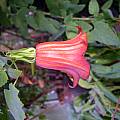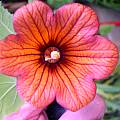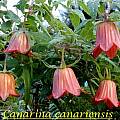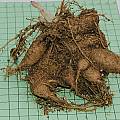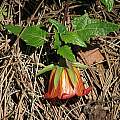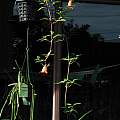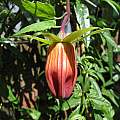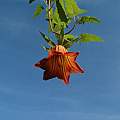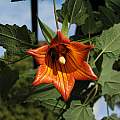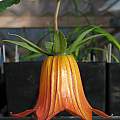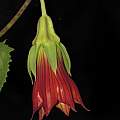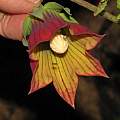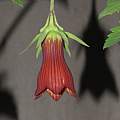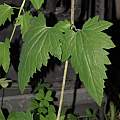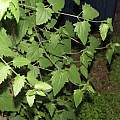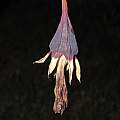Canarina is a genus in the Campanulaceae family with three species native to Africa and the Canary Islands.
Canarina abyssinica Engl. is an East African species found in montane forest, especially in clearings and in wooded grassland. It is distributed in Sudan, Ethiopia, Uganda, Kenya, and Tanzania. This species actively climbs and has a diagnostic twining loop in the flower pedicel. Flowers are pink to orange.
Canarina canariensis (L.) Vatke is endemic to the Canary Islands off the North African Atlantic coast, now a very popular tourist destination due to its reliably desert-like sunny climate year-round. But the higher elevations are yet covered with a relic of tertiary (a geological age classification) forest that acts as an important water trap by condensing water from the clouds. In this moist and cool but absolutely frost-free environment grows, besides other endemics, this stunning plant. It scrambles through scrub or hangs down cliffs. It forms a thick, fleshy, beet-like tuber and the shoots are annual, very herbaceous and slightly fleshy, with a marked dormancy during summer. Height: 6-8 ft.
Johannes-Ulrich Urban reports that in Germany, his plants come out of dormancy in August with tiny purple shoots at first that elongate quickly during autumn and winter, and form a big mass of scrambling, branching stems often more than 2 m (6 feet) long with a flower at each tip. He grows a nursery derived form that is compact, is more floriferous with larger flowers, and is more intensely coloured than wild forms. Flower size is approximately 7 cm (3 inches) long and 5 cm (2 inches) wide. He grows it in a large pot in very humusy, fertile soil and keep it in the open garden in half-shade during dormancy - but never totally dry. Once it sprouts he ties the shoots and fertilize from time to time. In winter, he lets it scramble over some structures in the greenhouse. Greenhouse temperatures are always above freezing, but cool to cold. With increasing temperatures in late spring it goes dormant, and completely sheds its shoots. Attempts to make seed by self pollination never came to fruition. The pollen and stigma do not ripen at the same time, but also another clone may be necessary to be successful. Division of the tuber is possible, but risky. Height range: 6-10 ft. Photos 1-2 were taken by Johannes-Ulrich Urban. Photo 3 was taken by Bill Dijk of plants he is growing in New Zealand. Photo 4 by Mary Sue Ittner is of the very large tuber. This plant was grown from seed. It seems much happier in coastal Northern California living in an unheated greenhouse than being exposed to our wet winters. The tuber is photographed on a grid of 1 cm squares. Photo 5 was taken by Nhu Nguyen at the UC Botanical Garden.
In the San Francisco Bay Area with its mild winters, Nhu Nguyen grows the plants in a one gallon (~3L) plastic pot outside in full sun where it also receives lots of natural rain. In late spring when the plant shows signs of dormancy, he allows the plants to go dormant. The plant may or may not completely shed its leaves and stem until fall when it is ready to grow again. The photos below were taken by Nhu Nguyen. This plant obtained from Telos Rare Bulbs seems to be a different form than the ones grown by Johannes-Ulrich Urban, Bill Dijk, and the UC Botanical Garden above.
Canarina eminii Asch. & Schweinf. is native to East Africa (Eastern Congo to Ethiopia, south to Malawi) where it grows in montane forest, riverine forest, and montane grassland. Height range: 6-8 ft.
Photos from Dylan Hannon who writes "Canarina eminii is an epiphytic species that has grown well in the Los Angeles area (away from the coast). Here it is a winter grower like Canarina canariensis, though it starts growth earlier in the fall just as nights start to cool. Both are dormant and kept dry in summer."
